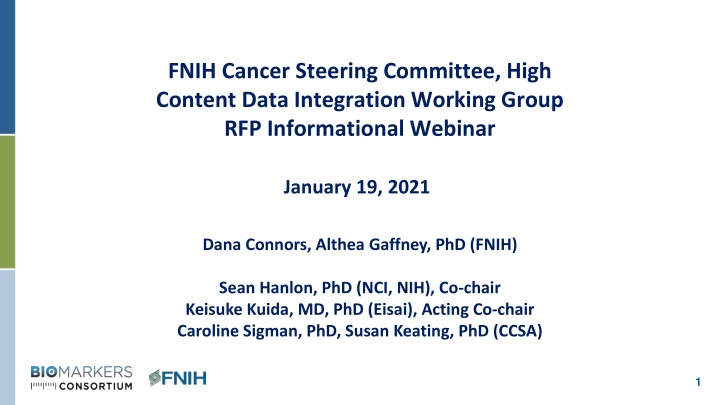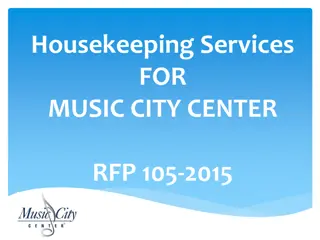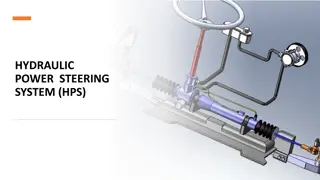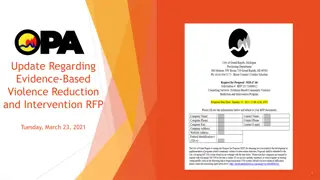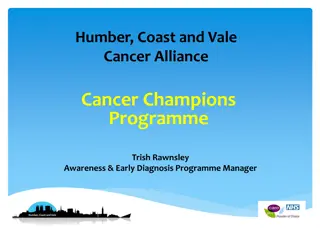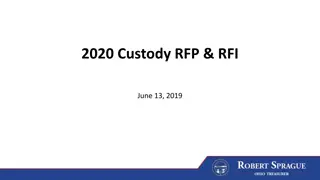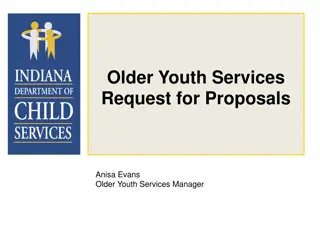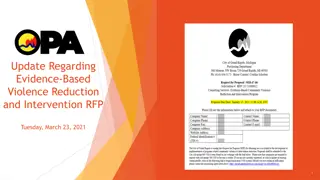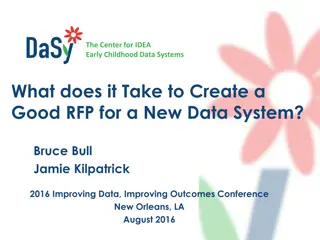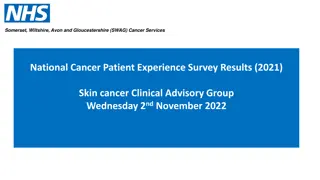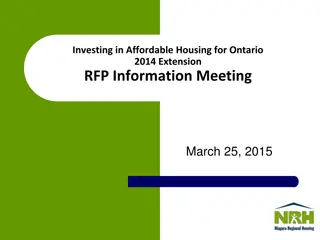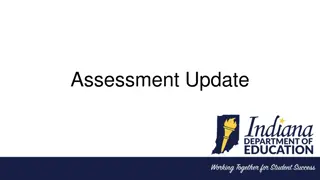FNIH Cancer Steering Committee RFP Information Webinar
The FNIH Cancer Steering Committee is hosting an informational webinar on the High Content Data Integration Working Group RFP. Learn about the RFP timeline, project development process, proposal attributes, and more. Discover how the Foundation for the National Institutes of Health (FNIH) supports breakthrough biomedical discoveries through alliances and partnerships.
Download Presentation

Please find below an Image/Link to download the presentation.
The content on the website is provided AS IS for your information and personal use only. It may not be sold, licensed, or shared on other websites without obtaining consent from the author.If you encounter any issues during the download, it is possible that the publisher has removed the file from their server.
You are allowed to download the files provided on this website for personal or commercial use, subject to the condition that they are used lawfully. All files are the property of their respective owners.
The content on the website is provided AS IS for your information and personal use only. It may not be sold, licensed, or shared on other websites without obtaining consent from the author.
E N D
Presentation Transcript
FNIH Cancer Steering Committee, High Content Data Integration Working Group RFP Informational Webinar January 19, 2021 Dana Connors, Althea Gaffney, PhD (FNIH) Sean Hanlon, PhD (NCI, NIH), Co-chair Keisuke Kuida, MD, PhD (Eisai), Acting Co-chair Caroline Sigman, PhD, Susan Keating, PhD (CCSA) 1
Agenda Introduction to FNIH and BC Introduction to the RFP and Clinical Challenges RFP timeline and logistics CSC Project development process Project proposal attributes Q&A Wrap-up 2
Introduction to FNIH and BC Mission Founded byCongress WhyCollaborate? Attract and share resources Enable insight and innovation Establish standards Distribute expertise Create consensus Drive competitiveness in marketplace Disseminateknowledge Enhancecredibility Reducecosts Support training & education Manage complexity The mission of the Foundation for the National Institutes of Health (FNIH) is to support the mission of the NIH. The FNIH creates and leads alliances and public-private partnerships that advance breakthrough biomedical discoveries and improve the quality of people slives. The FNIH was created by Congress in 1990 as a not-for-profit charitable organization. The Foundation began its work in 1996 to facilitate groundbreaking research at the U.S. National Institutes of Health (NIH) and worldwide. 2
Driving Principles of the Biomarkers Consortium BC projects bridge the gap between basic research and practical needs for advancing drug development and regulatory science. All work is pre-competitive, and results are released to the public as early as possible. Drug development tool projects are developed collaboratively with involvement from academic, government and industry scientists. Projects can be generated in any therapeutic area. All projects have specific, well-defined goals and are milestone-driven, including interim go/no-go funding gates. >35+ projects have been approved and initiated since the founding of the Consortium in 2006
Biomarkers Consortium Governance Executive Committee NIH / FDA / CMS / Industry / FNIH Steering Committees Metabolic Disorders Cancer Inflammation & Immunity Neuroscience Multiple Project Teams Representatives from NIH, FDA, Industry, Non-Profits and Academia Working Groups and Project Development Teams Representatives from NIH, FDA, Industry, Non-Profits and Academia 5
2022 Request for Project Concepts for Novel Biomarker Platforms to Support Clinical Imaging, Non-invasive Biopsy and Toxicity Challenges Cancer Steering Committee, High Content Data Integration Working Group The Request for Proposals (RFP) is for consortium efforts to develop novel biomarker platforms that support the mission of the BC Cancer Steering Committee (CSC) High Content Data Integration Working Group (HCDI WG). The mission of the HCDI WG is to develop and support pilot projects that test analytically validated platforms that employ emerging technologywith the potential to overcome limitations of established methodologies in the application of multi-dimensional biomarkers in a clinical setting. The working group is focused on technologies that have the potential to address recognized clinical challenges. 6
Clinical Challenges Challenge 1: Novel tissueimaging platforms to characterize the tumor and microenvironment, by providing insight into tumor heterogeneity and spatial relationships. Examples include approaches to: Quantify immune invasion of tumors as signatures for therapeutic response. Characterize subclonal dynamics for patient stratification. Characterize the stromal architecture and composition and associate these with efficacy and resistance. Note, examples of approaches are intended to give suggestions of potential applications that would fit the challenge and are not intended to specify the platforms that are requested. 7
Clinical Challenges (Continued) Challenge 2: Novel blood-based or remote sensing technologies that can be used to replace or augment solid tumor biopsies to enable meaningful clinical intervention opportunities (e.g., as an add-on and/or alternative tool to solid biopsies). Examples include tools to: Inform optimal timing for on-treatment biopsies. Generate tailored signatures for patient stratification. Understand cancer of unknown origin, tumor heterogeneity, or to detect emergence of drug resistance. 8
Clinical Challenges (Continued) Challenge 3: Patient screening platforms to identify potentially predictive biomarkers associated with toxicities/adverse effects that commonly lead to discontinuation of cancer clinical trial participation, such as thrombocytopenia, liver toxicity, neutropenia and gastrointestinal toxicity. Focus on platforms that can be integrated into trial protocols and emulate the complex interactions in the organ of interest. Examples include: Use of trial data, real-world data, and/or patient-generated data to determine parameters predictive of toxicity to incorporate in the screening platform, such as utilizing clinical features and data from wearable sensors to predict adverse events. Use of genetic associations with adverse events in clinical trial data to inform design of the screening platform. 9
RFP Timeline and Logistics Consortium projects are awarded contracts (not grants) administered by the FNIH. https://fnih.org/csc-hcdi-rfp Application Due Date: February 15, 2022, 11:59 PM ET Targeted application review period: February 15 April 5, 2022 Potential Oral Presentations from Finalists: Groups will be invited to present to the HCDI WG, May 3, June 7, or August 2, 2022. Final selection of proposals to recommend for CSC and EC review will be made in September 2022 Note: Proposal-specific guidance unavailable prior to submission. 10
Steps Between Submission and Award of a Contract Project concept proposals with broad interest across the HCDI WG members recommended for BC CSC review. Proposal selection and award is contingent upon merit and proper budget justification, proposals are not compared. Proposal reviewed by the BC Executive Committee (EC). PIs work with the HCDI WG to formalize the project plan (budget, timeline and milestone decision points), a project team including at least three industry funding partners, representatives from government and academic institutions, two co-chairs (a PI and an NCI or industry member). Note: the project concept may evolve during the process. The project plan undergoes final review by the BC CSC, then EC. The FNIH solicits funds from industry funding partners to support the project. The FNIH oversees the project goals and progress. PIs submit quarterly progress updates for the project. Approval of project milestone achievements linked to funding decisions are the responsibility of the project team. Applicants must agree to work with the project team to refine the overall project and specific project goals to align with the FNIH mission and the goals of industry funding partners. 11
Biomarkers Consortium Project Development Process Executive Committee (EC) Feasibility Review EC Approval SC Feasibility Review SC Concept Prioritization SC Review SC Approval Concept Development Working Group Concept Development Steering Committee (SC) Project Close Out Working Group Project Plan Execution Concept Development Project Plan Development Concept Development Working Group Concept Development Formalize Funding Agreements and Contracts SC Members Join Working Group(s) Working Group(s) adds members, transitions to PDT PDT Additional Companies Join PDT transitions to PET Project Execution Team (PET) Project Development Team (PDT)
Concept Plan SC EC SC Launch and Execution SC Concept Prioritization SC EC Feasibility Review Feasibility Review Review/Plan Development Close Out Approval Approval Project Overview Project Overview Project Overview Project Overview Project Overview Project Overview Scientific Design Scientific Design Scientific Design Scientific Design Scientific Design Data and IP Data and IP Data and IP Data and IP Data and IP Project Development Form (PDF) categories Timeline, Deliverables and Budget Timeline, Deliverables and Budget Timeline, Deliverables and Budget Timeline, Deliverables and Budget Timeline, Deliverables and Budget Project Management Project Management Project Management Project Management Project Management Project Execution Project Execution Business Development and Fundraising 13 Formalize Funding Agreements and Contracts Project Closeout
Project Proposal Attributes General Parameters for Project Proposals Design in phases for initial demonstration of the platform potential with an option for continuation to more expansive projects pending milestone achievements for go/no-go decisions. Participation of multiple institutions and principal investigators (at least one clinician), reflecting the consortium approach. Indicate the development status of the platform. Provide evidence of validation status, (demonstration of analytical validation is a minimum requirement), demonstration of feasibility (demonstrated fit to a clinical setting), standardization of the assay. Focus on practical, translational, and scalable approaches and biomarkers that can facilitate the evaluation of efficacy and prediction of response to therapies. Note the intended use of the proposed platforms and how they are an improvement over existing methodologies and sufficiently robust to support the development of FDA surrogate endpoints. 14
Application Proposal requirements are described in the RFP. Proposals should be 2-3 pages in length. Project Overview Summary of project and technology, the pre-competitive nature of the project. Project Scientific Design Scientific strategy/experimental plan, the technology/assay platform, definition of success given stated aims, outcomes, and deliverables, development status of the technology, supporting feasibility data, required specimen attributes. Timeline and Budget Budget justification with quantitative milestones tied to both timeline and budget. Not exceed $3 million over 4 years. Existing commercial or other funding relationships for the work, existing IP or patent information relevant to the technology platform that may affect its use in the partnership, or the banking of any resulting data funded by this effort in a public but controlled-access resource. 15
Design and Attributes of Successful BC Projects Examples of Project Deliverables Drug advancement Guidance Document Qualification Process Clinical use in drug development Citations in literature Generation of Peer reviewed publications Large unmet need Pre-competitive opportunity to advance the field Private sector buy-in with minimum 3 private partners involved during project development process Multiple public sector co-PIs Provides unique value to all stakeholders Ability to leverage other ongoing initiatives in the field (samples, data, scientific guidance, etc.) Strong interest from the regulatory sector Defined Context of Use early in the process 16
Concept Criteria Suitability: Are the goals of the project suitable for a partnership under The Biomarkers Consortium? Is the project pre-competitive? Scientific importance: Does the project fill a scientific gap? Will the project promote the understanding of the underlying pathobiology of the disease? Clinical importance: Will the project improve healthcare, serving a clinical need for diagnosis; assessment of disease activity, stage, severity, or outcomes; and/or provide useful information for the conduct of clinical trials? Regulatory importance: Will the project facilitate the development or approval of drugs or diagnostics? Feasibility: Is the study feasible operationally, technically and financially? Are the scientific resources and technology required available and proven? Is there a potential for commercialization? Commercial implications: Does the project foster and improve opportunities among industry competitors rather than relating specifically to a particular product in the competitive sphere? Additional criteria may come into play, such as: Proof of principle and readiness of a platform or concept Program balance and novelty of the idea Availability of resources and staff Likelihood of being able to secure funding 17
FAQs How many partners are sufficient for an initial consortium? More than 1. Multiple institutions (participating laboratories) and PIs with at least one clinician should be included. Projects ideally have 3 public sector co-PIs and 3 industry partners at launch. The FNIH and HCDI working group will also assist with recruiting partners during the project development process after a proposal is accepted. Are details of a follow-up plan needed as well as for a pilot? Yes. Projects should be designed in phases for initial demonstration of the platform potential with an option for continuation to more expansive projects pending milestone achievements for go/no-go decisions. Proposals should include: The scientific strategy, overall experimental plan and the technology platform or assay(s) to be tested as well as the definition of success given the stated aims, outcomes, and deliverables. A high-level timeline for the project, including each stage of the project with milestones and go/no-go decisions as appropriate. A high-level budget including the budget for each project stage. 18
FAQs (Continued) Is a two-step approach (initial pilot for feasibility followed by a separate review for broader testing and institutional involvement) appropriate as a response to this RFP or do we need to line up potential collaborations from the get-go? Yes, a two-step approach is possible. Collaborators can be included at the initial stage, additional collaborations will be explored following proposal approval, and likely later stage collaborators may join the project development team and/or added at the later stage in the project. Can multiple proposals be submitted? Yes. Proposals are not in competition with each other. Can proposed projects address cancer-related areas outside of immunotherapy? Yes. Is citizenship or being US-based required? No. Non-citizens and non-US based collaborators are welcome. 19
Q & A 20
Wrap-up 21
